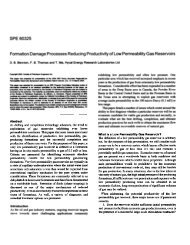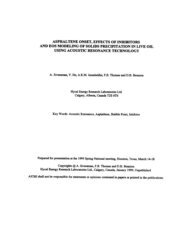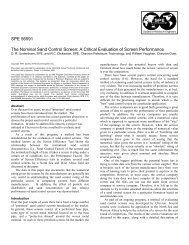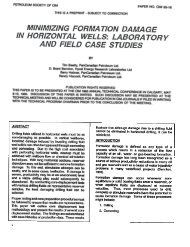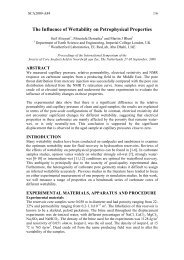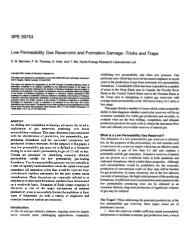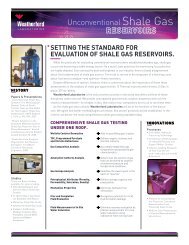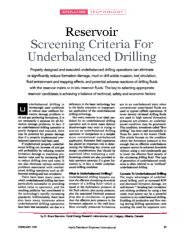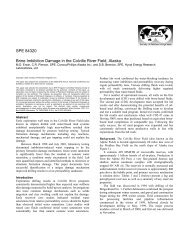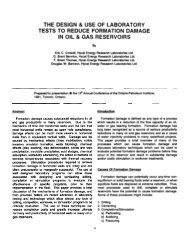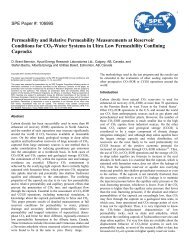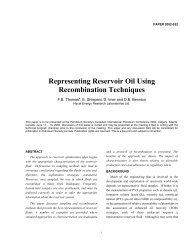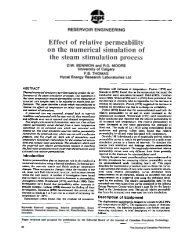Retrograde Condensate Dropout Phenomena in Rich Gas Reservoirs
Retrograde Condensate Dropout Phenomena in Rich Gas Reservoirs
Retrograde Condensate Dropout Phenomena in Rich Gas Reservoirs
Create successful ePaper yourself
Turn your PDF publications into a flip-book with our unique Google optimized e-Paper software.
D.B. BENNION, F.B. THOMAS, B. SCHULMEISTERHycal Energy Research Laboratories Ltd.AbstractCja!i conllcn!i:IIC rcscrvllirJI cxhihil<strong>in</strong>g cla!i!iic ..c.lcw p)<strong>in</strong>\ llrrclrllgr-oidc cllnc.lcn!i:1\C drop I'" heh.lvilltlr cxi!il <strong>in</strong> nulny arc.l~ <strong>in</strong>I~ world. Tht.-sc ~n'llirJI :trc unilluc <strong>in</strong> that. :t!i lhe ~n'llir(M\.~!iUre i!i I.k.",-"n ~. :t ccnOl<strong>in</strong> voluntl: of the l1.::tvy ~oo froclilm11I'lhe ga.. i.'i pn.",-"ipil:tI\.'tI <strong>in</strong> liquid rum1 fmm ~llulil1n <strong>in</strong> 111.: ~a!i.n1i!i cllnd~n!iOlle liquid may b~ Icmpl)rolrily I)r pc:rn1ancnlly1r-"p!)I..'tI <strong>in</strong> Ihl: re.'il:rvrnr. c:l'I!i<strong>in</strong>~ .'iI:Vl:rc n.'tIuctitln!i <strong>in</strong> ~0I!i prlldOClilll1rol,-~ aoo the pc:nn.lncnl 10!i... ur :I l..rgc Ixlnit)n uf Ihc\'uIOllik: ;tOO v:lluablc: \...mc.!cn.'iale liquitb Iduc: 10 cOlpill;ary pre!i-"lIre-iIWlM:\.'tI 1r;lpp<strong>in</strong>g .:rrt.",-"ls <strong>in</strong> the plnlU.'i tnc:tlial.Thi!i p.lp.:r rl:vic:\v~ Ih.: h:l~ic Ih':l'ry l)r g.l!i cund.:n!iollcJrI)pllllI alw c.Ic~bc!i. <strong>in</strong> l.k.'1O1il. d.lm:lgc pnml':l11!i Ih:ll nUlY 11.:;1!i~M:i:tIt.'tI with pnxlOClil1l1 of rc.'il:rvl)jrJI I" Ihi!i Iyp.:. Tc:chniquc!ifllr Inilig:tl<strong>in</strong>g coOOc:n!i:l\c droptlul prubl.:m!i I)n :I pnxlUClil)nhol!ii!i. a.. \vcll a~ !ililnulalilln 1t.",-"hni'IU\.~ ...uch a.. rcpre!i...uriwlilln.I.:an alw rich gol!i <strong>in</strong>j,:clil)n. !iurr:lctanl and ~)I\'.:nl <strong>in</strong>j.:ction. <strong>in</strong>!iilU l:'tlnhU!ilil)n :tnd w:tlcr/ga.. <strong>in</strong>jt.",-"lilln. .Ire re\"ic\vt.'tI. :too 11)t::KI\"anI3g':!i 31xJ di ll.lv3nl:t~'C!i l" 111.: 1t.'ChniqlJl:!i di~'t!i."'-'tI.Introduction<strong>Rich</strong> gas or retrograde condensate gu reservoirs are commonon a worldwide basis.Fi~ 1 JXOvides a pressure-composition diagram for a typicalhydrocarbon system at a fixed temperature level. The shaded p>rtionof this figure represents an area of two-phase equilibrium atthe specified composition and pressure condition. This is generallya region where an immiscible hydrocarbon liquid and gu phaseco-exist <strong>in</strong> thermodynamic equilibrium. Outside this area is a s<strong>in</strong>glephase region, where only one cont<strong>in</strong>uous and homogeneousuniform phase exists.Potential Problems Associated<strong>Gas</strong> <strong>Condensate</strong> Systemswith <strong>Rich</strong>The~ are two ma<strong>in</strong> categories of problems commonly associat-\.-d with rich gas reservoir systems:I. Fonnation damage effects associated with the condensatedropout2. Pennanent loss of valuable light condensate liquids due totrapp<strong>in</strong>g effects <strong>in</strong> the reservoir..~is paper addresses both of these issues and various techniquesthat can be used to rMuce their impact on productivity andrCCllVcry.Formation Damage Issues <strong>in</strong> <strong>Gas</strong><strong>Condensate</strong> <strong>Reservoirs</strong>The literature is replete with detailed discussions on fonnationdamage
<strong>in</strong>g situations, as many gas condensate reservoirs at discoveryconditions are at or very near the dewpo<strong>in</strong>t pressure of the gas.Even modest drawdowns applied <strong>in</strong> order to achieve economicproduction rates result <strong>in</strong> sub dewpo<strong>in</strong>t pressure productionaround the produc<strong>in</strong>g weDs.Drawdown can be reduced <strong>in</strong> many cases by <strong>in</strong>creas<strong>in</strong>g effectivebottomhole flow area through the use of high density perforat<strong>in</strong>g,open hole completions, horizontal wells and, <strong>in</strong> somecases, even by small fracture treatments (if fractur<strong>in</strong>g wiD notresult <strong>in</strong> water/oil production) <strong>in</strong> order to <strong>in</strong>crease bottomholeflow area which can reduce drawdown and damage effects.Mitigation TechniquesIn most situations, a certa<strong>in</strong> amount of damage due to condensatetrapp<strong>in</strong>g is unavoidable. This is even the case <strong>in</strong> a gas cycl<strong>in</strong>goperation as, <strong>in</strong> general, although the bulk of the reservoir isma<strong>in</strong>ta<strong>in</strong>ed at some pressure above the dew po<strong>in</strong>t value, the areaimmediately adjacent to the wellbore is often subjected to highdrawdowns which still result <strong>in</strong> localized condensate dropout Ingood quality reservoirs where the value of the critical mobile sablrationis low, this dropout may not appreciably affect flow rates(at least while reservoir pressure is high), and conventiODal primaryproduction may be the economic and technical option ofchoice. In many cases though, periodic treatments to attempt to"remove" a portion of the trapped condensate liquids from aroundthe wellbore are often used to try to <strong>in</strong>crease production rates.There are a number of potential techniques that have been suggestedor used recently for this purpose with vary<strong>in</strong>g degrees ofsuccess. They <strong>in</strong>clude:1. Static repressurization and imbibition2. Lean gas <strong>in</strong>jection3. <strong>Rich</strong> gas <strong>in</strong>jection4. Solvent <strong>in</strong>jection5. Mutual solvent <strong>in</strong>jection6. In situ combustion7. W ater <strong>in</strong>jection/displ~tStatic Repressurization and ImbibitionThe tenant of Ibis technique is based on the assumption of !hermodynamicreversibility. Exam<strong>in</strong>ation of Figure 1 <strong>in</strong>dicates that,theoretically, if production from the well is baIted (shut <strong>in</strong>) and ifthe bulk reservoir pressure is still high enough that over time thepressure <strong>in</strong> the depleted region around the weUbore is <strong>in</strong>creased toabove the orig<strong>in</strong>al dew po<strong>in</strong>t pressure, the condensate liquidswhich are trapped <strong>in</strong> the pore system should be "re-vapourized"<strong>in</strong>to the gas phase.Unfortunately, this technique enjoys limited actual success <strong>in</strong>porous media due to the limited <strong>in</strong>terfacial area, the revapouriza-lion process is extremely mass transfer limited (diffusion motivated)and hence very slow. Also, s<strong>in</strong>ce such a limited volume of gasis <strong>in</strong> contact with a given volume of condensate <strong>in</strong> d)e pore space(the condensate which is ttapped hav<strong>in</strong>g been precipitated out of ahuge volume of gas w~h has flowed through d)e pore space <strong>in</strong>comparison to the relatively small volume present <strong>in</strong> contact withit under static exposure), this once aga<strong>in</strong> severely limits theamount of revapourization that can occur.In a similar fashion, static imbibition (capillary pessure effects"wick<strong>in</strong>g" the ttapped condensate away from d)e wellbore deeper<strong>in</strong>to the formation) are only effective if the reservoir exhibitsstrongly oil wet natural wett<strong>in</strong>g tendencies. If d)e reservoir is neutralor water wet, there will be no spontaneous imbibition aff<strong>in</strong>itypresent to move the trapped saturation away from the near wellboreregion. S<strong>in</strong>ce many gas reservoirs do not conta<strong>in</strong> a liquidhydrocarbon saturation <strong>in</strong>itially, by default, <strong>in</strong> many cases, d)eyare water-wet <strong>in</strong> nature, and hence this negates imbibition as ameans of draw<strong>in</strong>g retrograded condensate liquids away from thewellbore.Exam<strong>in</strong>ation of Figure I also <strong>in</strong>dicates for some reservoir situationsthat if the pressure is dropped low enough, condensatebeg<strong>in</strong>s to revapourize once aga<strong>in</strong>. In some <strong>in</strong>stances, it is possible.at very low pressures and high temperatures, to pass completelyout of d)e two-phase region (through d)e "bottom" dew po<strong>in</strong>t l<strong>in</strong>eas illustrated <strong>in</strong> Figure I). Practically, once aga<strong>in</strong>, this med1od islimited <strong>in</strong> application. In most cases, the pressure at which substantiverevapourization beg<strong>in</strong>s to occur is well below the ec0-nomic abandonment pressure of the reservoir. Even if this is notd)e case, the re-vapourization process tends to be extremely slowand mass transfer-dom<strong>in</strong>ated when occurr<strong>in</strong>g <strong>in</strong> a static situation<strong>in</strong> porous media (<strong>in</strong> comparison to an agitated visual cell system<strong>in</strong> which the PVT measurements are normally conducted).Lean <strong>Gas</strong> InjectionThis technique enjoys more success, but generally requires relativelyhigh bottomhole pressure <strong>in</strong> order to be successful. Leangas <strong>in</strong>jection is generally conducted us<strong>in</strong>g either dry methane ornitrogen gas and uses high pressure vapouriz<strong>in</strong>g miscibility toextract the trapped condensate from the <strong>in</strong>jection region ~-<strong>in</strong>g the wellbore. In this case, because the <strong>in</strong>jection gas is lean <strong>in</strong>natum and conta<strong>in</strong>s 00 heavy end fraction, it has the capability ofextract<strong>in</strong>g a considerable amount of heavy ends from the system.6 Journal of Canadian Petroleum T~-:.ok)gy
S<strong>in</strong>ce <strong>in</strong>jection is occurr<strong>in</strong>g and new fluid is constantly mov<strong>in</strong>gthrough the pore system, convective and constant mass transfer isalso possible <strong>in</strong> comparison to the previously discussed static shut<strong>in</strong> methods. Hence, more rapid mass transfer and vapourizationeffects are present.The pressure required is highly dependent on the compositionof the trapped condensate aOO specific temperature and gu pr0perties.Generally higher pressures, usually <strong>in</strong> the 40 - 50 MParegion, are required for vapourlnng miscibility with pure nibogengu. Methane tends to have lower vapouri7iDg miscibility pressuJewith most condensates, often <strong>in</strong> the 30 40 MPa region.This technique is commonly used u a periodic stimulationmethod <strong>in</strong> many gas cycl<strong>in</strong>g operations as a readily availablesource of lean gas and compression facilities are already presenton-site. In many gu cycl<strong>in</strong>g operations, production wells are periodicallystimulated for a few days by dry gas <strong>in</strong>jection to removeaccumulated condensate and <strong>in</strong>crease production rates and reducedrawdown pressures.<strong>Rich</strong> <strong>Gas</strong> InjectionIn many reservoir situations. <strong>in</strong>sufficient presswe is present togenerate vapouriz<strong>in</strong>g miscibility with lean gas or nitrogen <strong>in</strong>jection.In these cases. similar miscible extraction/displacement ofthe condensate can be effected by the use of a higher molecularweight <strong>in</strong>jection gases such as ethane, propane or carbon dioxidewhich have much lower miscibility pressures with the trappedcondensate. Although effective. these medKIds are fairly expensiveto apply and concerns exist <strong>in</strong> some situations with respectopotential deasphalt<strong>in</strong>g of the condensate liquids by rich gas contact.Compatibility tests between the proposed <strong>in</strong>jection gas andthe reservoir condensate should be conducted to evaluate thisissue prior to execut<strong>in</strong>g a treatment of this type.Solvent InjectionThis process consists of the <strong>in</strong>jection of a liquid phase hydrocarbonsolvent (generally toluene, xylene or distillate) <strong>in</strong>to d)e formation.Although this method is often effective for remov<strong>in</strong>gwax/paraff<strong>in</strong> deposits that may be associated with ~~te pr0-duction <strong>in</strong> some wells, as I method for removal of "trapped" c0ndensate,the method is normally <strong>in</strong>effective as one simply substi-lutes one miscible hydrocarbon phase for another. In many cases,the IFf between the reservoir gas and an organic solvent, such axylene. is actually higher than that between the trapped condensateand the reservoir gas, which may actually result <strong>in</strong> an <strong>in</strong>crease<strong>in</strong> trapped hydrocarbon phase saturation.Mutual Solvent/Surfactant InjectionThis <strong>in</strong>cludes the <strong>in</strong>jection of high molecular weight alcohols(i.e., butanol), ocher mutual solvents and surfactants. The objectiveis to reduce the gas-condensate IFf which makes it easier torecover the ttapped condensate (e.g., lowers the value of the criticalcondensate saturation). Many alcohols have sludge and emulsionproblems with condensates and careful compatibility test<strong>in</strong>gshould be conducted. Often with many agents of this type, theactual reduction <strong>in</strong> gas-oil IFf is relatively slight and the overallstimulation effect may be marg<strong>in</strong>al. Careful 1FT and lab screen<strong>in</strong>gshould be conducted prior to execution to determ<strong>in</strong>e the effectivenessof any agent of this type for condensate removal.In Situ CombustionThis is a fairly novel technique which attempts to use air <strong>in</strong>jectionto ignite and "bum" the trapped condensate sablration out ofthe region <strong>in</strong> the near wellbore &rea. Most condensates are volatile<strong>in</strong> nature and will spontaneously ignite at reservoir temperaturesover about 120' C.Concerns with this method <strong>in</strong>clude high bouomhole temperaturesaDd cement degradation, effective propagation of the flood,ccxrosion CUICemS and well flashback. (explosion) coocems if allof the <strong>in</strong>jected oxygen is not consumed by combustion andLTO/HTO oxidation reactions with the <strong>in</strong> situ crude oil.Considerable resean:h wort is cunently underway evaluat<strong>in</strong>gthe use of this method. Accelerated rate calorimetric studies
sate is removed from dte near wellbore &rea, cont<strong>in</strong>ued productionbelow the dewpo<strong>in</strong>t pressure results <strong>in</strong> the recurrence of accumulationproblems. The economics of the treatment will thus beProvenance-Orig<strong>in</strong>al Petroleum Society manuscript,<strong>Retrograde</strong> <strong>Condensate</strong> <strong>Dropout</strong> <strong>Phenomena</strong> <strong>in</strong> <strong>Rich</strong> <strong>Gas</strong>highly dependent on the magnitude and length of the "flush" pr0-Reservoi~Impact on Recoverable Reserves, Permeability,duction period that is created after the stimulation treatment isDiagnosis, and Stimulation Techniques (TN2001-078), firstpresented at the Canadian International Petroleum Conferencecompleted.June 12-14, 2001, <strong>in</strong> Calgary, Alberta. Abstract submitted forreview December 12, 2000; editorial comments sent to theauthor(s) August 20, 2001; revised manuscript receivedConclusionsSeptember 19,2001; paper approved for pre-press October II,The mechanism of condensate dropout from rich gases has 2001, f<strong>in</strong>al approval December 3, 2001.&been discussed as one of the potential mechanisms reduc<strong>in</strong>g theproduction rate aJKI ~verable reserves of condensate liquids. InAuthors Biographiesgeneral, the value of the critical condensate saturation <strong>in</strong> porousmedia varies from I - 40% and is affected by IX>le geometry, wettability,<strong>in</strong>terfacial tension and capillary pressure and drawdownBrant Bennion is Hycal's president and isI a project eng<strong>in</strong>eer with over 20 years ofeffects. In most situations, porous media with <strong>in</strong> situ peImeabilitiesgreater than 1,000 mD exhibit low (less than S%) critical con-domestic and <strong>in</strong>tematiOllaJ technical expertise<strong>in</strong> the area of formation damage anddensate saturation values. Fonnaboo damage aJKI trapp<strong>in</strong>g issuesfluid flow <strong>in</strong> porous media. Brant hasare generally more severe <strong>in</strong> lower quality (sub-lOO mD) formationswhich exhibit more adverse capillary pressUIe characteris-I authored or co-autbored over 170 technicalpapers on a variety of subjecu, <strong>in</strong>clud<strong>in</strong>gtics. Means of reduc<strong>in</strong>g dropout problems, as well as remediationmulti-phase flow <strong>in</strong> porous media, formationdamage, underbalanced drill<strong>in</strong>g, fluidtechniques such as represurization, lean and rich gas <strong>in</strong>jection,solvent <strong>in</strong>jection and <strong>in</strong> situ combustion have been presented andphase behaviour and enhanced oil recovery.the specific advantages and disadvantages of each methodBrant received his B.Sc. <strong>in</strong> chemica] andreviewed.petroleum eng<strong>in</strong>eer<strong>in</strong>g from the University of Calgary with dist<strong>in</strong>ction<strong>in</strong> 1984. BraDt received Best Technical Paper of the Yearawards from the Petroleum Society <strong>in</strong> 1993 and 1995. Brant is aAcknowledgementsdirector of the Petroleum Society and is also a ~ber of APEG-The authors express appreciation to Hycal Energy ResearchGA and SPE (registered P .Eng). Brant wu also chosen to be aLaboratories for permission to presenthis material and to Vivian"Dist<strong>in</strong>guished Lecturer" for the SPE for 2001.Whit<strong>in</strong>g for her assistance <strong>in</strong> the ~on of the manuscript.REFERENCESI. ASADI, M., et aI., Effect of the Perfontion Damage on WellProductivity; pap.r SPE 27384 pr,s.nt.d at th, InternationalS)'mpo$iIIIII 011 FomllJdOll Damag' Control, lA/aY't", U, FebnlDry7 -10, 1994.2. BENNION, D.B., et aI., Remediation of Water and HydrocarbonPbue Tnpp<strong>in</strong>l Problems <strong>in</strong> Low Permeability <strong>Gas</strong> <strong>Reservoirs</strong>;P.trol,um Soci", paper No. ~80, pru,nt,d at tM 4~ ATM ofth,P~- Society, Calgary, AS. 1_10-12, 1996.3. ECONOMIDES, M.J., DEHGHANI, K., OGBE, D.O., andOSTBRMANN, RD., HysteIais Effects fw <strong>Gas</strong> CondensaIe WellsUlMierIo<strong>in</strong>g Bwldup Tau Below the Dew Po<strong>in</strong>t PressuM; pre.rmudat die 62..1 ATC of tile SPE, DaJJos. TX. Sepi.mber 27 - 30, 1987.4. HWANG, M.K. and ODEH, A.S., Estimation of <strong>Condensate</strong><strong>Dropout</strong> Effects On Well Productivity as Sk<strong>in</strong> Changes WithMultiplicative Interactions Among Sk<strong>in</strong> Components; ~r SPE29894 pres,nt,d at th, SPE Middk East Oil Show, Bahra<strong>in</strong>, March11- 14, 1995.5. HAMBERUN, C.W., at aI., Comb<strong>in</strong>ation of Selected Solvents andMutual Solvents Successful <strong>in</strong> Remov<strong>in</strong>g Hydrocarbon BasedFormation Damale; paper SPE 21572 pr,s,nt,dat th, Jo<strong>in</strong>tPetroleum SoderysPE Technical M,et<strong>in</strong>g. Calgary, AS, IUM 10 -13,1990.6. THOMAS, F.B., et al., Towards Optimiz<strong>in</strong>g <strong>Gas</strong> <strong>Condensate</strong><strong>Reservoirs</strong>; PIIroI Society paper No. 95-09, ~ at die 461'ATM ofdl, Pltroill/m Soci"" BaJ!ff; AB, lun.1995.7. THOMAS, P.B., et aI., Opcimiz<strong>in</strong>, Productioa Prom a <strong>Rich</strong> Gu<strong>Condensate</strong> Reservoir; paper SPEIDOE 35455, Tulsa, OK, April2/- 24,1996.8. YEAGER, V.J., Use of Downhole Diagnostics EnhancesDeterm<strong>in</strong>ation of Damage Mechanisms; Pr,s,nt,d at th, SPE1ntmlatiOftal SJIIIposium 011 FomlOtion Damag' COIIIrol. 1A/aY'II"U, SPE 39466, F.bruary 18 -19, 1998-9. BENNION, D.B., PomI8tiUI Damaae Dur<strong>in</strong>g UncJerl)a1aIICed andOverbalanced Drill<strong>in</strong>l Operations; Ph.D. Th~sis, Univ~rsity 0/Calgary,200J.10. Y ANNlMARA, D. V. and -nPPIN, D.L, ScreeII<strong>in</strong>g of Oil fw In SituCombustion at Reservoir Conditions Us<strong>in</strong>g Accelerat<strong>in</strong>g RateCalorimetry; ~r SPE 27791, pru./lt.d and tM 98' SPE EaRSymposium. Tul.ta. OX, April 17 - 20, 1994.Brent Thomas is Hycal's senior vicepresidentand is a project eng<strong>in</strong>eer work<strong>in</strong>g<strong>in</strong> the area of numerical simulation and gasI <strong>in</strong>jection. He received his Ph.D. fromWash<strong>in</strong>gton University <strong>in</strong> chemical eng<strong>in</strong>eer<strong>in</strong>g.Brent has over 20 years of domesticand <strong>in</strong>ternational experience <strong>in</strong> die areaI of numerical simulation, gas <strong>in</strong>jection,- - phase chemical behaviour, and thermal solids application. precipitation, He and has...uthored or co-authored over 130 technical papers and receivedthe 1992 Best Technical Paper of the Year award from thePetroleum Society (Experimental and Theoretical Studies ofSolids Precipitation from Reservoir Fluids). He was selected as a"Dist<strong>in</strong>guished Author" for die Petroleum Society <strong>in</strong> 1995.-- -Bernie Schulmelster is the eng<strong>in</strong>eer<strong>in</strong>gmanager at Hycal. He br<strong>in</strong>gs with him 20years of <strong>in</strong>dustry experience, IS of whichare directly focused on laboratory researchand services. He ma<strong>in</strong>ta<strong>in</strong>s a strong technicalbackground <strong>in</strong> the areas of petrophysicsand fonnation damage assessment and control.Experienced <strong>in</strong> manag<strong>in</strong>g and conduct<strong>in</strong>gapplied analysis. studies Currently <strong>in</strong> all ~ responsible of advanced core foroversee<strong>in</strong>g the eng<strong>in</strong>eer<strong>in</strong>g function of our <strong>in</strong>tegrated projectswhich <strong>in</strong>cludes special core analysis and phase behaviour. Bernieis a graduate of the Southern Alberta Institute of Technology witha diploma <strong>in</strong> petroleum eng<strong>in</strong>eer<strong>in</strong>g technology.8 Jownal of Canadian Petroleum Technology



